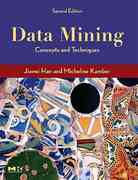Assume that a 10-D base cuboid contains only three base cells: (1) (left(a_{1}, d_{2}, d_{3}, d_{4}, ldots,
Question:
Assume that a 10-D base cuboid contains only three base cells: (1) \(\left(a_{1}, d_{2}, d_{3}, d_{4}, \ldots, d_{9}, d_{10}ight)\), (2) \(\left(d_{1}, b_{2}, d_{3}, d_{4}, \ldots, d_{9}, d_{10}ight)\), and (3) \(\left(d_{1}, d_{2}, c_{3}, d_{4}, \ldots, d_{9}, d_{10}ight)\), where \(a_{1} eq d_{1}, b_{2} eq d_{2}\), and \(c_{3} eq d_{3}\). The measure of the cube is count ( ).
a. How many nonempty cuboids will a full data cube contain?
b. How many nonempty aggregate (i.e., nonbase) cells will a full cube contain?
c. How many nonempty aggregate cells will an iceberg cube contain if the condition of the iceberg cube is "count \(\geq 2\) "?
d. A cell, \(c\), is a closed cell if there exists no cell, \(d\), such that \(d\) is a specialization of cell \(c\) (i.e., \(d\) is obtained by replacing a \(*\) in \(c\) by a non-* value) and \(d\) has the same measure value as \(c\). A closed cube is a data cube consisting of only closed cells. How many closed cells are in the full cube?
Step by Step Answer:

Data Mining Concepts And Techniques
ISBN: 9780128117613
4th Edition
Authors: Jiawei Han, Jian Pei, Hanghang Tong





